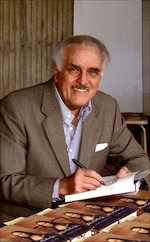Leonardo and the Intersection of Art and Science
Bulent Atalay
Tuesday, May 13, 2014 at 2:00 P.M. in the H.J.E. Reid Auditorium
(Video of the lecture) within the Langley firewall only
Abstract
Leonardo da Vinci is known as a supreme artist, the creator of some of the most famous works in the history of art. What is less well known is that he was only a part-time artist.
His relentless curiosity to understand the world drove him to study nature, make careful observations, seek mathematical proofs, and record all his findings. Some of his discoveries preceded achievements we associate with Galileo, Newton, and Darwin. He even prefigured entire sciences not to be formally invented for centuries. With unrivaled drafting skills, he created mechanical drawings for futuristic technology and anatomical studies that would never be equaled.
When he created his miraculous paintings, he imbued them with his scientific passions — his intuitive knowledge of aerodynamics, optics, geology, hydrology, physics and mathematics. Leonardo was in the business of inventing the future. But since he never published his discoveries, he did not materially influence it.
This lecture looks at Leonardo’s grand achievements as a creator who approached science through art and art through science and the tragedy of his long-unheralded status as a visionary.
Speaker
 Described by NPR, the Washington Post, and the National Geographic Society as a 21st Century Renaissance Man, Bulent Atalay is an artist, author, and scientist. He is a professor emeritus of physics at the University of Mary Washington, adjunct professor at the University of Virginia, and a member of the Institute for Advanced Study at Princeton, and the author of Math and the Mona Lisa (Smithsonian Books, 2004) now in 14 languages, and Leonardo’s Universe (National Geographic Books, 2009). His website (not within the NASA domain) appears at www.bulentatalay.com.
Described by NPR, the Washington Post, and the National Geographic Society as a 21st Century Renaissance Man, Bulent Atalay is an artist, author, and scientist. He is a professor emeritus of physics at the University of Mary Washington, adjunct professor at the University of Virginia, and a member of the Institute for Advanced Study at Princeton, and the author of Math and the Mona Lisa (Smithsonian Books, 2004) now in 14 languages, and Leonardo’s Universe (National Geographic Books, 2009). His website (not within the NASA domain) appears at www.bulentatalay.com.
Chad Stephens is hosting our speaker this month.